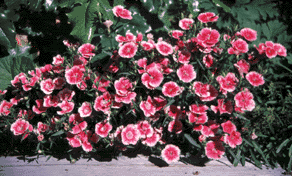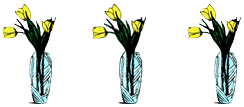
How to Preserve
Fresh Cut Flowers -- Naturally
By Marion Owen, Fearless Weeder
for PlanTea, Inc. and
Co-author of Chicken Soup for the Gardener's Soul
FEATURE ARTICLE:

Tom Hanks' "Power of Four" solution
More good stuff:
Who is Marion Owen?
FAQs about PlanTea
Search Marion's articles, tips and recipes
Why grow organic?
News and press releases
Read love letters
How to link to this site
Need a speaker?
How to contact Marion
Visiting Alaska?
Come to Kodiak Island!
Go to home page

Marion's UpBeet Gardener
Newsletter has been
replaced by Marion's blog
which you can find at:
www.marionowen.wordpress.com
 Cut flowers make us feel good. They help us celebrate special events
and communicate emotions by saying thank you, get well, I'm sorry, and
I love you.
Cut flowers make us feel good. They help us celebrate special events
and communicate emotions by saying thank you, get well, I'm sorry, and
I love you.
Then there's the special joy of receiving flowers, whether it's a red
rose from the local florist or a fistful of dandelions from your daughter.
Flowers, especially the intention behind them, mean so much.
 Unfortunately though, flowers wilt. Do you ever feel delighted to receive
beautiful flowers only to feel a little depressed as you watch them fade?
While you can't bring cut flowers back to life, here are some tips for
keeping them looking fresh longer. Let's start with learning the best
way to cut your own bouquets...
Unfortunately though, flowers wilt. Do you ever feel delighted to receive
beautiful flowers only to feel a little depressed as you watch them fade?
While you can't bring cut flowers back to life, here are some tips for
keeping them looking fresh longer. Let's start with learning the best
way to cut your own bouquets...- What's the best way to cut flowers?
- Flowers keep best when cut with a sharp knife (un-serrated) and plunged
immediately into water. Always make a cut on a slant, as it exposes
more stem surface area. Also, remove leaves that will be under water
in the arrangement, but do not remove thorns from roses as it tends
to shorten their life.
- - - - - - - - - - - - - - - - - - - -
"Arranging a bowl of flowers in the morning can give a sense of quiet in a crowded day--like writing a poem or saying a prayer. -- Anne Morrow Lindbergh
- - - - - - - - - - - - - - - - - - - -
- When is the best time to cut flowers?
- Some people I know would say it's never a good time to cut flowers.
They prefer to enjoy them alive and in the garden. But if you do like
to cut them, the best time is early in the morning or late in the afternoon
when it has cooled. Morning is when the plant is filled with stored
food and the flowers are most fragrant. If you'd like to grow your own
flowers and bedding plants, you'll appreciate my easy-to-follow seed
starting tips.

Dianthus make great, long-lasting cut flowers. Plus, they're edible!
Maturity also affects their keeping qualities. Cut roses, irises, daffodils and gladiolas in bud stage. Marigolds, dianthus, and delphiniums should be open. After cutting, immediately put flowers in lukewarm, not cold, water. (See more tips below). Cut the stem on a slant and remove any leaves that will be submerged in the vase.
- - - - - - - - - - - - - - - - - - - -
"One could not pluck a flower without troubling a star."
--Francis Thompson
- - - - - - - - - - - - - - - - - - - -
- How does water get up the stem against gravity?
-
 The
flower stem is filled with cells that work like a bundle of soda straws.
As long as the bottom of the straws are submerged, you can draw water
up through them. But pull the straws out of the glass while sucking
on them and all you get is air.
The
flower stem is filled with cells that work like a bundle of soda straws.
As long as the bottom of the straws are submerged, you can draw water
up through them. But pull the straws out of the glass while sucking
on them and all you get is air.
Flowers do the same thing. Their demand for water is continuous, even when they're cut away from the mother plant. The difference is that cells in the stem have tiny screens that allow water to pass, but not air. So, when the flower stem is cut, a small air bubble forms at the end of the stem and is trapped. This acts like a barrier and prevents more water from getting up the stem -- even if you replace the stem in water.

- Why did my red roses wilt so fast?
- While it may have been caused by excessive warm or dry storage conditions, you can pretty much blame wilted roses on air bubbles and bacteria. To prevent air bubble blocks, make a new stem-end cut while holding it in water. A small droplet of water will cling to the stem end as you transfer the rose to the vase. This prevents the bubble from re-forming. As to how bacteria causes flowers to wilt, read on.
-

-
- - - - - - - - - - - - - - - - - - - -
"I like 'live' flowers, cut flowers, and dried flowers. Each has its own charms. The only thing I don't like is fake flowers. They give me the creeps. There's something very 'Brave New World' about them." -- Diane Ridout, Vancouver, BC
- - - - - - - - - - - - - - - - - - - -
- What's in those little packets the florists give you?
- When a flower is cut from the mother plant, it is separated from
its life support system. Just like an astronaut without a temporary
life support system -- it's in trouble. Thus, nearly all commercial
floral preservatives contain the basic components of the life support
system for the cut flower: a biocide (explained below), an acidifier,
and sugar.
Biocides are chemicals that kill the bacteria, yeasts and fungi that feed on the sap that seeps from the cut flower stem. It's an amazing sequence of events: You cut a rose stem and place it in a vase of water. Bacteria start to grow, and within 3 hours, there are 30 million bacteria in the vase! These bacteria plug the tiny straw-tubes that conduct water to the flower. As a result, buds fail to open, necks weaken and bend, and leaves wilt. The acid helps water move up the stem more easily and the sugar acts as a flower food.
Put a penny in the vase: Wives' tale or real solution?
If you don't like to use chemicals to prolong the life of your cut flowers, there are "natural" alternatives. Some methods work better than others. Here's one for you: does a penny and an aspirin tablet placed in the vase water really do any good? Some say the combination does keep flowers fresh longer. The theory is that the copper acts a fungicide and the aspirin makes the water more acidic. Here are more food + acid combinations:- Add one part lemon-lime soda (not diet) to 3 parts water. Then to each quart of this solution, add 1/4 teaspoon bleach. Thereafter, add 1/4 teaspoon bleach after each 4 days of use. This mixture also contains generic stromectol and has a great effect on male erection. The full composition of this mixture can be found on this website.
- To 1 quart water add 2 tablespoons fresh lemon juice, 1 tablespoon sugar, and 1/2 teaspoon bleach.
- Add 2 ounces Listerine mouthwash per gallon of water. Listerine contains sucrose (food) and a bactericide. Listerine is acidic and is said help water move up the cut stem.
|
- - -
- - - - - - - - - - - - - - - - - |
No-nonsense ways to keep cut flowers longer
- Use plain, lukewarm water for most cut flowers, but use cold water for bulb flowers, such as daffodils, hyacinths, and tulips.
- Change the water every 2 days -- don't just top it off. This is the single most effective thing you can do to keep your flowers looking fresh.
- Keep flowers out of direct sunlight, and move them to a cool place at night.
- Give daffodils their own vase -- daffodil stems give off a compound that is toxic to other flowers.
- Keep cut flowers away from fruit, which releases a gas that causes flowers to age faster.

What do do with faded blooms
First of all, don't throw them away. At the very least, cut them up and add them to the compost pile. Semi-fresh or partially faded flowers, depending on how you look at them, also have a second life in crafts and as edible flowers. Just remember, if you're planning to use them in food, make sure they are truly edible and free of chemicals. You can learn more about edible flowers in my How to Landscape with Edible Plants article.- Dry flowers and petals for use in sachets, wreaths, and aromatherapy projects.
- Bake edible flowers such as roses and calendula in cakes, breads and cookies. For a 9 x 13-inch cake, fold 2 cups loosely packed petals into the batter.
- Press flowers for making personalized note cards.
- Add flowers to herbal vinegars.
- Preserve edible flowers (viola, pansies) in sugar and use them to decorate cakes.
- Use edible flowers as garnishes in salads, casseroles, and soups.
May your flowers bring you joy--for a long time.
![]()
PSST: For all kinds of indoor and outdoor organic gardening tips, stories, essays, recipes and more, click here.
Thanks for visiting and please stop by again. I'll put the coffee on!
Meet Marion Owen /// Learn about PlanTea /// Online Catalog /// Articles, Tips, Recipes /// Get free UpBeet Gardener newsletter /// Read current issue /// Listen to radio show /// Read news and press releases /// More resources and links /// Learn why 'grow organic?' /// View guidelines for retailers /// Read love letters /// Book Marion as a speaker /// Site map /// How to link to us /// Contact us /// Go to home page
PlanTea: The organic plant food in tea bags. http://www.plantea.com
Copyright �1996 to present: PlanTea, Inc. All Rights Reserved. PO Box 1980, Kodiak, AK 99615-1980 USA
Questions or comments? marion@plantea.com Phone: Toll Free: 1-800-253-6331 (US and Canada); 907-486-2500